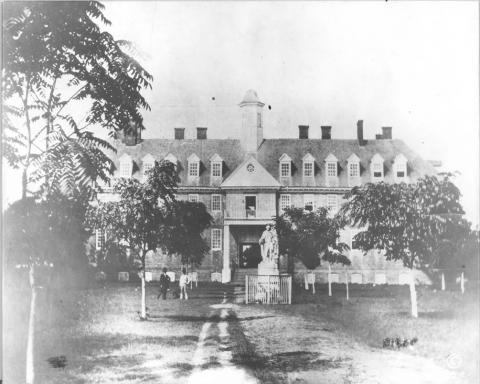
Constructed: 1695-1700
Burned: 1705, 1859, 1862
Restored: 1928-1931
Renovated: 1967, 1999-2000
Map it for me
Affectionately known as “the soul of the college,” the Sir Christopher Wren Building is often shortened to either the Wren Building or the College Building. The oldest collegiate building still in use in the country, the Wren Building is a National Historic Landmark and is listed on the United States National Register of Historic Places. Built between 1695-1700, its construction began before Williamsburg was founded and while Jamestown was the capital of the Colony of Virginia.
The Wren Building anchors the Historic Campus and remains a vital part of William & Mary - containing the Great Hall, the Wren Chapel, numerous graves, classrooms, offices, and the Department of Religious Studies.
Atop the Wren, a weathervane displays a metallic 1693 banner - the founding date of the second oldest college in the U.S.
Overview
The Historic Campus - the Wren Building, the Brafferton, the President’s House, and the Wren Yard - sits at the heart of 300+ years of education. Within the walls of Wren, generations of students have attended classes, eaten meals, recited prayers, and reveled in celebratory events. The north wing contains the Great Hall, while the south wing includes the Chapel.
As described by William & Mary professor Hugh Jones in 1724: "The Building is beautiful and commodious, being first modeled by Sir Christopher Wren, adapted to the nature of the country by the gentlemen there."
Initial Construction
The royal charter of the college was granted by King William III and Queen Mary II on February 8, 1693, naming James Blair as the first president. The charter provided nearly £2000 and 20,000 acres of land as an endowment, while authorizing a penny per pound tax on tobacco exported from Maryland and Virginia to countries other than England and profits from the surveyor general's office.
Despite its name, there is no evidence that Sir Christopher Wren had any direct involvement in the building’s design. However, he decidedly inspired it. Constructed of red bricks laid in Flemish bond, it resembled most official structures of the late 17th-early 18th century colonial architecture. The first portion constructed was the front and north wing of the building, with a roof only on the front. "By April 1697 College accounts showed total expenditures of £3889.1.10 on construction, £170 over available funds" (Godson et. al., 1994, p. 31).
It’s difficult to convert £3889.1.10 into the costs of 2024, as noted by UNC ("The Value of Money in Colonial America"). The National Archives places it around $825,000, while other economists calculate it above 1.36 million dollars. A better comparison would be the Trinity College Library at Cambridge University. Its 17th century construction (from a pro bono design by Wren) tallied £16,425 (Building the Wren Library).
Thomas Jefferson's Addition
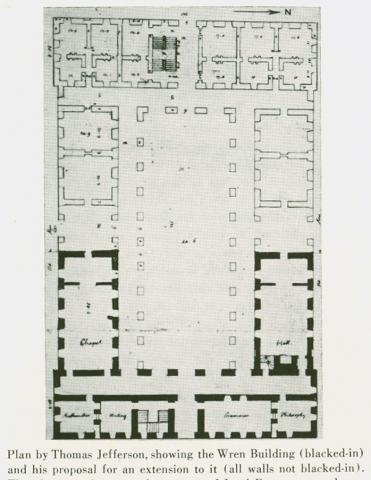
Around 1772, Virginia Royal Governor Lord Dunmore approached House of Burgesses Member Thomas Jefferson to develop a significant addition to the College Building. Designing a quadrilateral structure, his proposal would have nearly doubled its size.
The September 3, 1772, issue of the Virginian Gazette advertised a solicitation of bids for its construction: "Notice is therefore given, to all persons willing to undertake this work, that a plan thereof is lodged with Mr. Matthew Davenport, who will be ready at all times to show the same and to whom they are desired to send their estimates and proposals, sealed up, on or before the first day of October next." A local builder, John Saunders, was awarded the contract.
The Bursar noted on November 8th and 9th, 1774, an order to purchase London materials to “by new building.” The west wing foundations were laid, however, the American Revolution permanently suspended further construction. By 1780, William & Mary were selling the materials worth £500 “upon the most reasonable terms.”
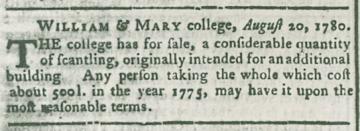
These foundations were accidentally uncovered in 1940 while planting trees. No further excavations occurred for ten years. After meeting with President Pomfret, James M. Knight of Colonial Williamsburg and A. Edwin Kendrew, Vice President in charge of the Department of Architecture, discovered that the foundations for the side walls between the existing building and the Jefferson addition were never laid.
Another accidental excavation occurred in June 1977, when construction crews digging a trench for pipe installation stumbled upon the Jefferson foundation.
Renovation & Wrenovation
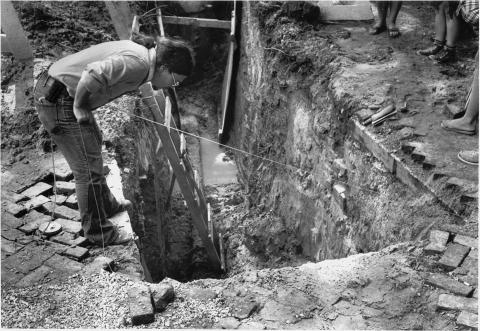
Since 1967, the Wren Building has undergone two extensive renovations. The first was featured in the September 22, 1967, edition of the Flat Hat.
Another renovation - dubbed Wrenovation - occurred as the building was entering into its fourth century of use. The major foci were restoration of the architectural features such as floors and paneling; replacement of mechanical, electrical, and plumbing systems; safety upgrades; and conservation of the masonry walls.
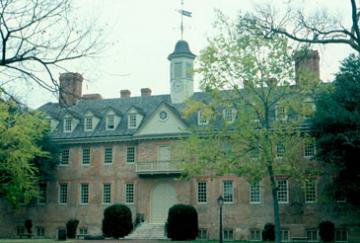
Fires
Three fires devastated the Wren Building over its 325+ year history. Each time the interior of the building was reconstructed inside the original walls
The first gutted the building in October 1705. The interior and the library were completely lost, except for one book - Paolo Sarpi’s 1676 work The history of the Council of Trent : containing eight books, in which besides the ordinary acts of the Council are declared many notable occurrences which happened in Christendom, during the space of forty years and more; and particularly the practices of the Court of Rome, to hinder the Reformation of their errours, and to maintain their greatness. This book resides in William & Mary’s Special Collections Research Center.
The building and library were again destroyed on February 8, 1859. A fragment of the College Bell survived and remains in the University Archives. Lectures resumed on October 13, 1859.
The final destruction occurred in September 1862, when the Pennsylvania 5th Cavalry burned the building as part of the Peninsula Campaign of the Civil War.
Lord Botetourt Statues
Lord Botetourt was so revered by Virginians they honored him with a statue, which stood first at the Old Capitol. It was then purchased by William & Mary in 1801. Other than a brief period during the Civil War when it was moved to the Public Asylum for safety, it stood in the College Yard until 1958. It was removed for protection from the elements and installed in the new Swem Library in the Botetourt Gallery.
A replica bronze statue by William & Mary alumnus Gordon Kray was installed in the College Yard in 1993. It is tradition to dress the statue for holidays and special events such as hanging a wreath on the statue's outstretched hand in December.
Cannon
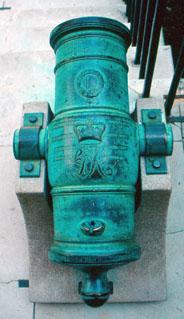
Two artillery weapons flank the Wren Building’s east door. They were captured from the British after the Battle of Yorktown in 1781. The initials "GR" represent George Rex - King George II of Great Britain - as they were cast during his reign.
The cannon in the yard was taken from Fort Christanna, a trading post which was established by Royal Governor Alexander Spotswood south of the James River in 1713.
Bust of Thomas Jefferson
In 1949, "through the action of the Governor William Munford Tuck after a resolution of the Board of Visitors, the college was awarded a bust of Thomas Jefferson, which had been included among the gifts to the Old Dominion donated by a grateful French population (via the "Merci Train") in response to this country's ‘Friendship Train’ of last year." (The Flat Hat, March 22, 1949) This bisque porcelain bust - part of the Muscarelle Museum of Art collection - is currently displayed in the Great Hall over the west door.
Plaques Honoring Veterans and War Dead
Revolutionary War
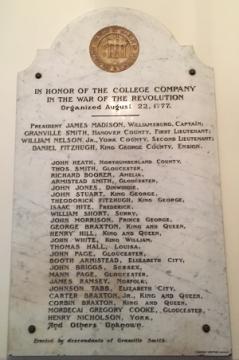
The Revolutionary War plaque in the Wren Building honors the men of the College of William & Mary who served in the College Company during the American Revolution.
IN HONOR OF THE COLLEGE COMPANY
IN THE WAR OF THE REVOLUTION
Organized August 22, 1777
- PRESIDENT JAMES MADISON, WILLIAMSBURG, CAPTAIN;
- GRANVILLE SMITH, HANOVER COUNTY, FIRST LIEUTENANT;
- WILLIAM NELSON JR., YORK COUNTY, SECOND LIEUTENANT;
- DANIEL FITZHUGH, KING GEORGE COUNTY, ENSIGN.
- JOHN HEATH, NORTHUMBERLAND COUNTY,
- THOS. SMITH, GLOUCESTER,
- RICHARD BOOKER, AMELIA,
- ARMISTEAD SMITH, GLOUCESTER,
- JOHN STUART, KING GEORGE,
- THEODORICK FITZHUGH, KING GEORGE,
- ISAAC HITE, FREDERICK,
- WILLIAM SHORT, SURRY,
- JOHN MORRISON, PRINCE GEORGE,
- GEORGE BRAXTON, KING AND QUEEN,
- HENRY HILL, KING AND QUEEN,
- JOHN WHITE, KING WILLIAM,
- THOMAS HALL, LOUISA,
- JOHN PAGE, GLOUCESTER,
- BOOTH ARMISTEAD, ELIZABETH CITY,
- JOHN BRIGGS, SUSSEX,
- MANN PAGE, GLOUCESTER,
- JAMES RAMSEY, NORFOLK,
- JOHNSON TABB, ELIZABETH CITY,
- CARTER BRAXTON, JR., KING AND QUEEN,
- CORBIN BRAXTON, KING AND QUEEN,
- MORDECAI GREGORY COOKE, GLOUCESTER
- HENRY NICHOLSON, YORK,
- And Others Unknown.
Erected by descendants of Granville Smith.
Memorial to French Soldiers in the Siege of Yorktown
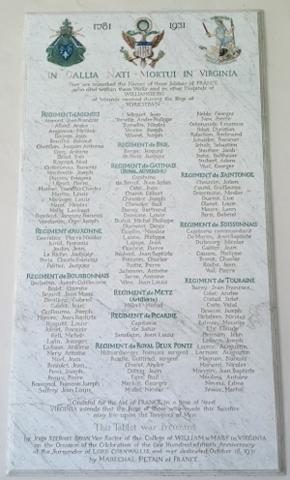
The Memorial Table to French Soldiers who died in Williamsburg from wounds received during the siege of Yorktown, 1781, was erected October 18, 1931.
The plaque reads as follows:
1781 1931
IN GALLIA NATI MORTUI IN VIRGINIA
Here are inscribed the Names of those Soldiers of FRANCE
who died within these Walls and in other Hospitals of
WILLIAMSBURG
of Wounds received during the Siege of
YORKTOWN
REGIMENT d'AGENOIS
- Aimont, Jean Francois
- Allard, Andre
- Angevaise, Nicolas
- Bagage, Jean
- Bouillot, Benoist
- Chatillon, Jacques Antoine
- Cocq, Antoine
- David, Yves
- Fugenot, Noel
- Guiboiseau, Francois
- Hauteville, Joseph
- Hursin, Francois
- Lignot, Pierre
- Marival, Francois Charles
- Martin, Louis
- Menager, Louis
- Naret, Nicolas
- Nolly, Laurent
- Papelard, Jacques Francois
- Verdavoir, Oger Joseph
REGIMENT d'AUXONNE
- Gorrelier, Pierre Nicolas
- Iund, Francois
- Joulin, Jean
- Le Riche, Jacques
- Paris, Claude Francois
- Pelitier, Jacques
REGIMENT DE BOURBONNAIS
- Barbaton, Joseph Guillaume
- Bedel, Etienne
- Besard, Jean Marie
- Devillers, Gabriel
- Galotet, Jean
- Guillaume, Joseph
- Honore, Jean Baptiste
- Huguet, Louis
- Jolivet, Francois
- Kell, Michel
- Lafin, Jeangeri
- La Fosse, Antoine
- Mery, Antoine
- Noel, Jean
- Paniolet, Jean
- Prou, Joseph
- Proux, Pierre
- Rossignol, Francois Joseph
- Saffroy, Jean Louis
- Seliquet, Jean
- Terville, Andre Philippe
- Tumelin, Nicolas
- Verrier, Joseph
- Villaret, Joseph
REGIMENT de BRIE
- Berger, Jacques
- de Paris, Jacques
REGIMENT de GATINAIS (ROYAL AUVERGNE)
- Capitaine De Sireuil, Jean Jarlan
- Catel, Jean
- Charet, Gilbert
- Chevalier, Joseph
- Chevalier, Paul
- Daray, Bertrand
- Decoune, Louis
- Dufut, Michel Philippe
- Dumont, Denis
- Guelin, Nicolas
- Laine, Philippe
- Lajoye, Jean
- Ozanne, Pierre
- Paulard, Jean Baptiste
- Pierson, Charles
- Riotte, Pierre
- Sallemon, Antoine
- Serve, Antoine
- Vitre, Jean Louis
REGIMENT de METZ (Artillerie)
- Millert, Michel
REGIMENT de PICARDIE
- Capitane de Satur Sansfacon, Jean Louis
REGIMENT de ROYAL DEUX PONTS
- Hiltzenberger, Francois, sergent
- Rouffe, Gottfried, sergent
- Cheret, Andre
- Dittzer, Jean
- Egre, Paul
- Merkot, Georges
- Muller, Nicolas
- Neble, Georges
- New, Pierre
- Orkensude, Erasmus
- Pabst, Christian
- Robichon, Ferdinand
- Scholder, Francois
- Scholt, Sebastien
- Stautzer, Jacob
- Stohe, Balthazar
- Stubert, Adam
- Vbel, Georges
REGIMENT de SAINTONGE
- Chauvin, Julien
- Coutel, Guillaume
- Determine, Nicolas
- Ducros, Luc
- Glanet, Louis
- Maure, Leon
- Paris, Gabriel
REGIMENT de SOISSONNAIS
- Capitaine commandant DeMarin, Jean Baptiste
- Dubourg, Nicolas
- Galtier, Jean
- Gausse, Philippe
- Provot, Charles
- Roche, Jean Vial, Pierre
REGIMENT de TOURAINE
- Barey, Jean Francois
- Colar, Andre
- Costail, Sidet
- Coste, Vidal
- Devaise, Joseph
- Dididiere, Nicolas
- Edmon, Maurice
- Ely, Claude
- Hermain, Jean
- Lefevre, Joseph
- Lersne, Augustin
- Lormier, Augustin
- Magnan, Francois
- Monard, Nicolas
- Mongin, Jean Baptiste
- Moulins, Antoine
- Neveu, Edme
- Savoix, Martial
Grateful for the Aid of FRANCE in a time of Need VIRGINIA intends that the Fame of those who made this Sacrifice may live upon the Tongues of Men
This Tablet was Presented by JOHN STEWART BRYAN, Vice Rector of the College of WILLIAM & MARY in VIRGINIA on the Occasion of the Celebration of the One Hundred & Fiftieth Anniversary of the Surrender of Lord Cornwallis and was dedicated October 18, 1931 by MARECHAL PETAIN of FRANCE
Civil War
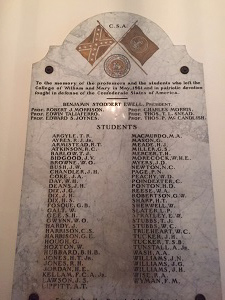
The Civil War Confederate volunteers plaque was erected in 1914. The text of the plaque follows. Note that names appearing on the same lines below are presented in columns on the plaque. This plaque is currently housed in the Special Collections Research Center.
C.S.A.
In the memory of the professors and the students who left the College of William & Mary in May, 1861 and in patriotic devotion fought in defense of the Confederate States of America
- BENJAMIN STODDERT EWELL, PRESIDENT.
- PROF. ROBERT J. MORRISON. PROF. CHARLES MORRIS.
- PROF. EDWIN TALIAFERRO. PROF. THOS. T. L. SNEAD.
- PROF. EDWARD S. JOYNES. PROF. THOS. P. MC CANDLISH.
STUDENTS
- ARGYLE, T. R. MACMURDO, M. A.
- AYRES, R. J. JR. MASON, G.
- ARMISTEAD, R. T. MEADE, H. J.
- ATKINSON, R. C. MILLER, G. S.
- BARLOW, T. J. MERCER, T. H.
- BIDGOOD, J. V. MORECOCK, W. H. E.
- BROWNE, W. O. MYERS, J. D.
- BUSH, J. W. NEWTON, N. C.
- CHANDLER, J. H. PAGE, P. N.
- COKE, J. A. PEACHY, W. D.
- DAY, W. H. POINDEXTER, C.
- DEANS, J. H. PONTON, H. D.
- DIX, J. G. REESE, W. A.
- DIX, J. H. ROBERTSON, G. W.
- DIX, H. S. SHARP, H. T.
- FOSQUE, G. B. SHERWELL, W.
- GALT, W. SLATER, L. P.
- GEE, S. H. SPRATLEY, E. W.
- GWYNN, W. O. STUBBS, T. J.
- HARDY, J. STUBBS, W. C.
- HARRISON, C. S. TRUEHEART, W. C.
- HARRISON, G. E. TUCKER, J. H.
- HOUGH, G. TUCKER, T. S. B
- HOXTON, W. TUNSTALL, A. JR.
- HUBBARD, B. H. B. WASH, A. A.
- JONES, H. T. JR. WILLIAMS, J. N.
- JONES, R. H. WILLIAMS, J. G.
- JORDAN, H. E. WILLIAMS, J. H.
- KELLAM, F. C. A. JR. WISE, R. A.
- LAWSON, J. S. WYMAN, F. M.
- LIPPITT, A. T.
Erected by the Board of Visitors and the Alumni of the College, 1914
World Wars I and II
The World War I and World War II plaques in the Wren Building were erected in May, 1948. A temporary plaque of the WWII casualties was unveiled on Alumni Day in June, 1944.
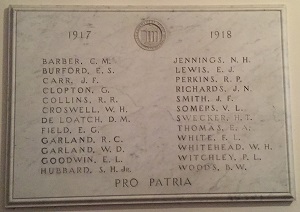
World War I Plaque
1917 1918
- BARBER, C. M.
- BURFORD, E. S.
- CARR, J.F.
- CLOPTON, G.
- COLLINS, R. R.
- CROSWELL, W. H.
- DE LOATCH, D. M.
- FIELD, E. G.
- GARLAND, R. C.
- GARLAND, W. D.
- GOODWIN, E. L.
- HUBBARD, S. H. JR
- JENNINGS, N. H.
- LEWIS, E. J.
- PERKINS, R. P.
- RICHARDS, J. N.
- SMITH, J. F.
- SOMERS, V. L.
- SWECKER, H. T.
- THOMAS, E. A.
- WHITE, F. L.
- WHITEHEAD, W. H.
- WITCHLEY, P. L.
- WOODS, B. W.
- PRO PATRIA
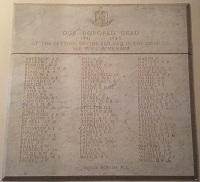
World War II Plaque
OUR HONORED DEAD
1941-1945
AT THE SETTING OF THE SUN AND IN THE MORNING
WE WILL REMEMBER
- ANDERSON, J. R.
- ANDREWS, J. V.
- BEMBOW, W. V.
- BENJOVSKY, T. D. JR.
- BLAGG, J. A.
- BLAIR, W. J.
- BOHANNAN, R. E.
- BOTTALICO, J. J.
- BOYSEN, F. O.
- BYRD, G. B. JR.
- CAMP, J. D.
- CHESS, P. S. JR.
- COSGROVE, A. S.
- COWDEN, C. G.
- COX, R. M. JR.
- CRAWFORD, M. JR.
- DALE, C. H.
- DAVENPORT, J. B. JR.
- DAVIDSON, J. T.
- DE BELL, J. T. JR.
- DENNIS, S. A.
- DONNELLY, R. E. JR.
- DOULIS, P. P.
- DOWNING, W. E.
- DOZIER, W. L. JR.
- DUNN, J. N.
- EASLEY, J. W.
- ELDRIDGE, J JR.
- FIELDS, H. H. JR.
- FLICKINGER, W. S.
- FOLKES, J. T.
- FOX, A. C.
- GALL, R. F.
- GARNETT, C. N.
- GILL, C. W.
- GRAY, G. M.
- GREMBOWITZ, J. F.
- GRYMES, W. B.
- HAGERMAN, C. E.
- HALL, S. H.
- HARDY, H. P. JR.
- HART, E. K.
- HEATH, J. G.
- HECKER, S. A.
- HENDRICK, C. B. JR.
- HOGGE, N.
- HOLLAND, G. L.
- HOLLAND, J. M.
- HUMBER, C. I. JR.
- JOHNS, H. H.
- JOHNSON, D. M.
- JOHNSTON, R. C.
- LAFFERTY, E. E.
- LAMBERT, P. M.
- LANG, A. C.
- LAPOLLA, M. O.
- LAUGHON, S. W.
- LAWSON, J. C. JR.
- LEVY, J. K.
- LOUDEN, W.
- MAISCH, H. C.
- MARSH, W. C.
- MATTSON, R. B.
- MAY, J. D.
- MOORE, C. H. JR.
- MOUGEY, J. T.
- MUSBACH, W. F.
- PALMER, J. D.
- PALMER, N. D.
- PHILLIPS, E. E.
- PYLE, B. T.
- RANG, F. B.
- RASMUSSEN, B. R.
- ROBERTS, H. C. JR.
- ROUNDTREE, C. E. JR.
- SANDERS, R. D. JR.
- SHRYOCK T. J. III
- SMIDL, R. C.
- SMITH, A. D.
- STUART, D. B.
- TAFFE, J. V.
- TAYLOR, E. R. JR.
- TULLEY, C. D. JR.
- TWIDDY, C. A. JR.
- VAN BUREN, J. M.
- VIDETO, R. H.
- WALKER, C. H.
- WATKINS, J. M.
- WENIGER, J. F.
- WHEELER, H. F.
- WILKINSON, J. F.
- WOHL, D. P. JR.
- FACULTY BORISH, M. E.
Korean and Vietnam Wars
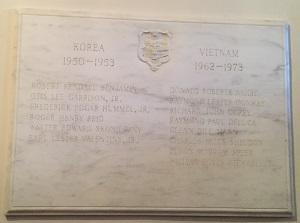
The plaque featuring alumni who served in the Korean and Vietnam wars was erected in the Wren Building on November 15, 1986.
Korea-Vietnam Plaque
KOREA
1950 - 1953
- ROBERT KENDALL BENJAMIN
- OTIS LEE GARRISON, JR.
- FREDERICK EDGAR HUMMEL, JR.
- ROGER HENRY REID
- WALTER EDWARD SKONIECZNY
- EARL LESTER VALENTINE, JR.
VIETNAM
1962 - 1973
- DONALD ROBERTS ASHBY
- RAYMOND LESTER CONWAY
- RICHARD JOHN CURRY
- RAYMOND PAUL DELUCA
- GLENN DILL MANN
- CHARLES MILLS SHELDON
- BYRON MORROW SPEER
- WILLIAM LOUIS STEWART, JR.
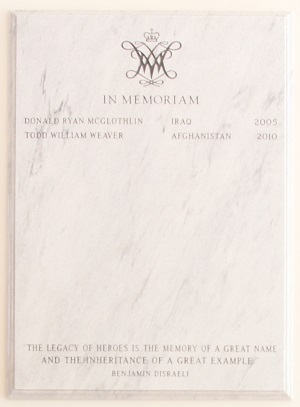
Wars in Iraq and Afghanistan
In 2014, a new plaque was placed on the wall in the Wren entryway honoring those that died in the wars in Iraq and Afghanistan.
IN MEMORIAM
- DONALD RYAN MCGLOTHLIN IRAQ 2005
- TODD WILLIAM WEAVER AFGHANISTAN 2010
"THE LEGACY OF HEROES IS THE MEMORY OF A GREAT NAME
AND THE INHERITANCE OF A GREAT EXAMPLE"
BENJAMIN DISRAELI
Burial Vaults
A crypt is located under the chapel in the Wren Building. The crypt is not accessible to the public. What is known about each vault:
A. Sir John Randolph (d. 1737) and Lady Susanna Beverley Randolph (d. after 1754); tomb opened in 1858 and perhaps 1862.
B. John Randolph (d. 1784, body transferred from London and burial date unknown); opened in 1858 and probably in 1862; repaired in 1929.
C. Peyton Randolph (d. 1775, buried 1776) and Elizabeth Harrison Randolph (d. 1783); opened in 1858, 1859 and probably 1862. Mrs. Randolph's remains placed in Mr. Randolph's lead coffin and both transferred to Vault G on May 30, 1929.
D. Lord Botetourt (d. 1770); opened and robbed in 1862 and 1969; opened by Lyon G. Tyler between 1888 and 1919.
E. Bishop James Madison (d. 1812) and possibly Mrs. Madison (d. 18?); probably opened in 1862. Remains placed in a lead box and transferred to vault G on May 30, 1929.
F. Grave of Chancellor Robert Nelson (?) (d. 1818); excavated 1858 and August 1928.
G. See Vaults C & E.
H. President Thomas R. Dew (d. 1846, buried 1939).
? Judge Thomas Nelson (d. 1813); burial place unknown.
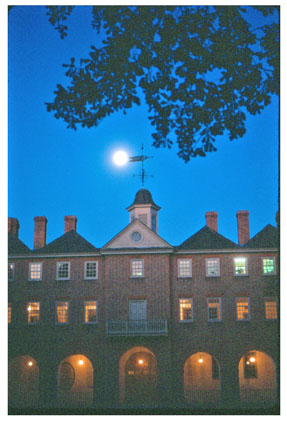
References
- Godson, S., Johnson, L., & Sherman R. (1994). The College of William & Mary: A History. King and Queen Press.
- "The Sir Christopher Wren Building" and "Jefferson's William & Mary" pamphlets from Office of the Historic Campus Records, Special Collections Research Center, Earl Gregg Swem Library, The College of William & Mary.
- Journal of the Society of Architectural Historians, Vol. 10, No. 3, October, 1951, pg. 28-31.
- "Discovery of the Foundations" by Kocher and Dearstyne, in "Wren Building-1615-1799," University Archives Subject File Collection, Special Collections Research Center, Earl Gregg Swem Library, The College of William & Mary.
- Virginia Gazette (Dixon and Nicholson), September 13 and 20, 1780.
- Virginia Gazette, July 15, 1977.
- French Soldiers: see Plaques-French Soldiers in University Archives Subject File Collection.
- Confederate Soldiers: see Plaques-Confederate Soldiers in University Archives Subject File Collection.
- WWI and WWII: see Plaques-WWII in University Archives Subject File Collection.
- Korean, Vietnam, and Cold Wars: see Alumni Gazette, May 1985, page 5.
Material in the Special Collections Research Center
- Search the SCRC Collections Database for the many references to the Wren Building:
- Historic Campus Records, Special Collections Research Center, Swem Library, William & Mary.
- University Archives Photograph Collection, Special Collections Research Center, Swem Library, William & Mary.
- University Archives Subject File Collection, Special Collections Research Center, Swem Library, William & Mary.
- Office of the President, Special Collections Research Center, Swem Library, William & Mary.
- University Archives Artifact Collection, Special Collections Research Center, Swem Library, William & Mary.
- For blueprints see the Facilities Management Records, Special Collections Research Center, Swem Library, William & Mary.
- James D. Kornwolf, So good a design : the colonial campus of the College of William & Mary : its history, background, and legacy, Williamsburg, Va. : College of William & Mary, Joseph and Margaret Muscarelle Museum of Art, 1989. Swem stacks and Archives Books: call number: LD6051 .W53 K67 1989.
- David Sacks, The history of the William & Mary campus, Thesis (Honors), College of William & Mary, 1984. Virginia reference and Archives Books: call number: LD6051 .W5m Fine A., 1984, S32.
- For further material in Swem Library's book collection (including Archives Books, theses, and dissertations), search the Library Catalog using the subject heading "Wren Building (Williamsburg, Va.)" or "College of William & Mary Buildings."
In the News
- "Wren archeological dig continues to hit pay dirt", William & Mary News, August 6, 2007.
- Kindling enthusiasm in College's foundation, The Flat Hat 28 September 2007.
- What Do the Wren Yard Cannon and the Indian School Have in Common?, William & Mary Alumni Magazine, Winter 2008, Volume 74, Number 2.
External Links
- William & Mary - History of the Wren Building
- William & Mary - Historic Campus
- William & Mary - Photos of the Wren Chapel
